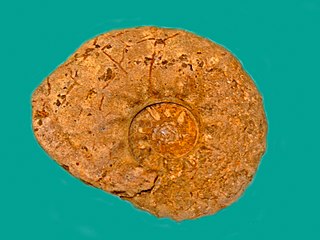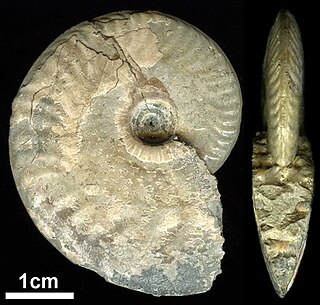Related Research Articles
Karamaiceras is an extinct cephalopod genus belonging to the Ammonoidea that lived during the Early Cretaceous. Its shell is involute, smooth and rather compressed, with the outer whorl strongly embracing the inner whorls. Sides are flattish to slightly convex and slope inwardly toward a narrowly rounded venter.
Aioloceras is an ammonite, order Ammonitida, from near the end of the Early Cretaceous. The shell is compressed with the outer whorl covering much of the previous. Sides are slightly convex, converge toward a narrowly ached venter. Inner whorls have sharp falcoid ribs, outer are smooth. Umbilical tubercles are lacking. Similar related forms include Neosaynella and Cleoniceras.
Axonoceras is a genus in the ammonitid family Nostoceratidae proposed by Stephenson in 1941, for "slender shells coiled in a plane with numerous closely spaced ribs and two rows of ventral nodes'...The shells may be closely coiled, though not involute, but most... are more or less loosely and irregularly coiled". Shells may be coplanar or coiled in a low flat spiral with the early whorls in contact, later whorls free.

Arcticoceras is an extinct ammonoid cephalopod genus from the late Middle Jurassic belonging to the ammonite family Cardioceratidae, more commonly found to high northern latitudes.
Balticeras is an involute, discoidal Upper Jurassic (Oxfordian) ammonite found in England, Germany, and Switzerland, belonging to the Perisphinctidae. The shell is strongly embracing, tending to be oxyconic. Sides are gently curved, converging on a narrow to sharp ventral rim.
Barremites is an ammonoid cephalopod belonging to the family Desmoceratidae, that lived during the Hauterivian and Barremian stages of the Early Cretaceous. Its shell is moderately to very involute, with the outer whorl strongly embracing the inner whorls, and variably compressed. Sides are generally smooth and marked with sinuous or falcate collars marking intervals of growth and bearing feeble striae to moderately distinguished ribs.

Barroisiceras is an acanthoceratacean ammonite from the Upper Cretaceous, Coniacian, included in the family Collignoniceratidae.

Parapuzosia is an extinct genus of desmoceratid ammonites from the Cenomanian to the Campanian of Africa, Europe, and North America. They are typically very large ammonites, reaching diameters of 60 cm (2.0 ft) or more, with the largest species measuring upwards of more than 2.5 m (8.2 ft). It possesses a moderately involute shell with flat or slightly rounded sides. Distinct primary and secondary ribbing can be observed in the inner whorls.
Fissilobiceras is a smooth, compressed, involute ammonite from the lower Middle Jurassic of Europe, named by Buchman in 1919. It is assigned to the hildoceratoid family, Hammatoceratidae.
Euaptetoceras is an evolute hildoceratoid ammonite from the lower Middle Jurassic, included in the family Hammatoceratidae and the subfamility Hammatoceratinae. The genus may be a junior synonym for Eudmetoceras of Buckman, 1920.

Durotrigensia is a genus of ammonites (Ammonitida) in the perisphinctoid family Parkinsoniidae.
Dorsetensia is a narrowly coiled discoidal ammonite from the early Middle Jurassic, lower Bajocian, belonging to the family Sonniniidae of the superfamily Hildoceratoidea. The inner whorls are ribbed or smooth, outer whorl is smooth. The outer rim (venter) is narrow, with a keel running along the middle. The umbilicus, the opening in the middle of the shell exposing inner whorls, is of moderate size with a sharp, sometimes undercut edge.

Oxycerites is an extinct ammonoid cephalopod belonging to the haploceratoid family, Oppeliidae, that lived during the Middle Jurassic.
Neoptychites is an extinct ammonoid cephalopod genus from the Turonian stage of the Upper Cretaceous, with a worldwide distribution.

Craspedites is an ammonoid cephalopod included in the Perisphinctaceae that lived during the Late Jurassic and Early Cretaceous, found in Canada, Greenland, Poland, and the Russian Federation.

Hauericeras is an ammonite genus from the Late Cretaceous that lived from the Coniacian to the late Maastrichtian, from about 90 to 66 mya. Fossils have been found in Europe, Russia, South Africa, Australia, India, Iraq, and in the United States.

Harpoceras is an extinct genus of cephalopod belonging to the family Hildoceratidae. These cephalopods existed in the Jurassic period, during Toarcian age from Falciferum zone to Commune subzone of Bifrons zone. They were fast-moving nektonic carnivores.
Ochetoceras is a genus of ammonites, belonging to the Oppeliidae, that lived during the Late Jurassic from the early Oxfordian to the early Tithonian, and type for the subfamily Ochetoceratinae.

Hammatoceras is a genus of ammonites belonging to the family Hammatoceratidae which lived during the Late Toarcian stage of the Early/Lower Jurassic between about 184 and 175 million year ago.
Radstockiceras is an extinct genus of lower Jurassic ammonite that lived from Oxynotum zone of upper Sinemurian to Raricostatum zone of lower Pliensbachian. Shells of these animals were oxycone and involute with umbilicus that took maximum of 12% of diameter in the case of outer whorls. On inner whorls, venter has been sharp, but then it became rounded. Faint ribs had falcoid shape, but sometimes, ribs could absent. Shells could have been large in their size. Suture has been very complex, similar to Oxynoticeras, but culmination at umbilical margin has been missing. Genus has been named after town of Radstock, in Somerset.
References
- 1 2 Sepkoski, Jack (2002). "Sepkoski's Online Genus Database" . Retrieved 2014-05-28.Cite journal requires
|journal=(help)
- Treatise on Invertebrate Paleontology, Part L; Ch. Mesozoic Ammonoidea. Geological Soc of America and U Kansas Press, R.C Moore (ed)